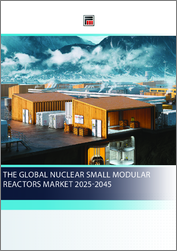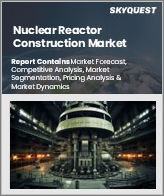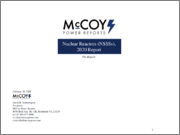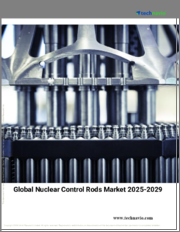
|
시장보고서
상품코드
1728194
세계의 원자로 건설 시장 : 산업 규모, 점유율, 동향, 기회, 예측 - 원자로 유형별, 용도별, 지역별, 경쟁별(2020-2030년)Nuclear Reactor Construction Market - Global Industry Size, Share, Trends, Opportunity, and Forecast, Segmented By Reactor Type, By Application, By Region, By Competition, 2020-2030F |
||||||
세계의 원자로 건설 시장 규모는 2024년 545억 달러로 평가되었고, 2030년 623억 달러에 이를 것으로 예측되며, 예측 기간 동안 CAGR 2.1%로 성장할 전망입니다.
깨끗하고 안정적인 에너지원에 대한 수요 증가는 에너지 안보와 기후 변화 목표를 위해 각국이 화석 연료를 대체하는 것을 요구하고 있기 때문에 주요한 추진력이 되고 있습니다. 원자력 에너지는 특히 에너지 수요가 증가하는 가운데 저탄소로 대규모 해결책을 제공합니다. 소형 모듈식 원자로(SMR)나 제4세대 기술 등의 혁신은, 비용 효율, 안전성 및 확장성을 향상시켜, 세계의 에너지 전환에 있어서 원자력의 실행 가능성을 강화하고 있습니다. 자금 지원 및 인센티브 등 정부의 지원 정책이 개발을 가속화하고 있습니다. 게다가 신흥 경제국에서는 노후화된 인프라의 근대화가 성장 기회를 가져오고 있습니다. AI 및 자동화 등의 디지털 기술이 안전성과 운전 효율을 향상시키는 한편, 국제적인 협력 체제의 강화나 환경 지속 가능성에 관한 사회적 의식의 고조가 원자력을 미래 에너지 전략의 중요한 요소로 자리매김하고 있습니다.
| 시장 개요 | |
|---|---|
| 예측 기간 | 2026-2030년 |
| 시장 규모(2024년) | 545억 달러 |
| 시장 규모(2030년) | 623억 달러 |
| CAGR(2025-2030년) | 2.1% |
| 급성장 부문 | 가압수형 원자로 |
| 최대 시장 | 북미 |
시장 성장 촉진요인
깨끗하고 신뢰할 수 있는 저탄소 에너지에 대한 수요 증가
주요 시장 과제
고액의 설비투자 및 건설 기간 장기화
주요 시장 동향
소형 모듈로(SMR) 및 선진로 기술의 성장
목차
제1장 개요
제2장 조사 방법
제3장 주요 요약
제4장 고객의 목소리
제5장 세계의 원자로 건설 시장 전망
- 시장 규모 및 예측
- 금액별
- 시장 점유율 및 예측
- 원자로 유형별(가압수형 원자로, 비등수형 원자로, 신형 원자로)
- 용도별(베이스 로드 발전, 담수화 및 프로세스열, 해양 추진, 기타)
- 지역별(북미, 유럽, 남미, 중동 및 아프리카, 아시아태평양)
- 기업별(2024년)
- 시장 맵
제6장 북미의 원자로 건설 시장 전망
- 시장 규모 및 예측
- 시장 점유율 및 예측
- 북미 : 국가별 분석
- 미국
- 캐나다
- 멕시코
제7장 유럽의 원자로 건설 시장 전망
- 시장 규모 및 예측
- 시장 점유율 및 예측
- 유럽 : 국가별 분석
- 독일
- 프랑스
- 영국
- 이탈리아
- 스페인
제8장 아시아태평양의 원자로 건설 시장 전망
- 시장 규모 및 예측
- 시장 점유율 및 예측
- 아시아태평양 : 국가별 분석
- 중국
- 인도
- 일본
- 한국
- 호주
제9장 중동 및 아프리카 원자로 건설 시장 전망
- 시장 규모 및 예측
- 시장 점유율 및 예측
- 중동 및 아프리카 : 국가별 분석
- 사우디아라비아
- 아랍에미리트(UAE)
- 남아프리카
제10장 남미의 원자로 건설 시장 전망
- 시장 규모 및 예측
- 시장 점유율 및 예측
- 남미 : 국가별 분석
- 브라질
- 콜롬비아
- 아르헨티나
제11장 시장 역학
- 성장 촉진요인
- 과제
제12장 시장 동향 및 발전
- 합병 및 인수
- 제품 출시
- 최근 동향
제13장 기업 프로파일
- GE-Hitachi Nuclear Energy, Inc.
- Westinghouse Electric Company LLC(토시바)
- KEPCO Engineering & Construction
- SKODA JS as
- China National Nuclear Corporation
- Bilfinger SE
- Larsen & Toubro Limited
- Doosan Corporation
제14장 전략적 제안
제15장 기업 소개 및 면책사항
AJY 25.05.27The Global Nuclear Reactor Construction Market was valued at USD 54.5 billion in 2024 and is anticipated to reach USD 62.3 billion by 2030, registering a CAGR of 2.1% during the forecast period. Growing demand for clean and stable energy sources is a major driver as nations seek alternatives to fossil fuels for energy security and climate goals. Nuclear energy offers a low-carbon, large-scale solution, especially as energy demand rises. Innovations such as Small Modular Reactors (SMRs) and Generation IV technologies are improving cost efficiency, safety, and scalability, reinforcing nuclear's viability in the global energy transition. Supportive government policies, including funding and incentives, are accelerating development. Additionally, modernization of aging infrastructure in developed economies presents growth opportunities. Digital technologies like AI and automation are enhancing safety and operational efficiency, while increased international collaboration and public awareness around environmental sustainability are positioning nuclear energy as a critical component in future energy strategies.
| Market Overview | |
|---|---|
| Forecast Period | 2026-2030 |
| Market Size 2024 | USD 54.5 Billion |
| Market Size 2030 | USD 62.3 Billion |
| CAGR 2025-2030 | 2.1% |
| Fastest Growing Segment | Pressurized Water Reactors |
| Largest Market | North America |
Key Market Drivers
Rising Demand for Clean, Reliable, and Low-Carbon Energy
The global shift toward decarbonization and energy sustainability is increasing the focus on low-emission energy sources. Nuclear energy has emerged as a dependable solution due to its ability to deliver uninterrupted baseload electricity with minimal greenhouse gas emissions. As industrial activity and population growth push up energy consumption-projected to rise 30% by 2040 per IEA estimates-nuclear power is being adopted to bridge the gap left by intermittent renewables. Its reliability makes it a strategic complement to solar and wind, ensuring consistent grid performance. Countries like Bulgaria have initiated new reactor projects using advanced technologies, reflecting growing global momentum for nuclear investment to meet net-zero targets and energy demand simultaneously.
Key Market Challenges
High Capital Investment and Extended Construction Timelines
The nuclear sector faces significant hurdles related to high upfront investment and prolonged construction periods. Building a nuclear power plant typically involves billions in capital, along with complex engineering, stringent regulatory compliance, and extended approval processes. These factors can delay projects by 5 to 15 years, creating financial uncertainty. Construction setbacks due to technical complications, permitting delays, and changes in policy can further escalate costs. In emerging markets with limited financing options, these barriers can deter adoption in favor of quicker and less expensive alternatives like gas or renewables. The long lead times and cost overruns continue to challenge the sector's growth trajectory despite its clean energy potential.
Key Market Trends
Growth of Small Modular Reactors (SMRs) and Advanced Reactor Technologies
The adoption of Small Modular Reactors (SMRs) and next-generation nuclear technologies is reshaping the market landscape. SMRs are designed to address the high cost and complexity of traditional large-scale reactors by offering modular, scalable solutions with shorter construction times and improved safety. These reactors are factory-built, reducing on-site labor and time while enabling phased deployment based on demand. Their compact size and advanced safety features-such as passive cooling systems-make SMRs ideal for remote areas, developing countries, and industrial applications requiring reliable local power. As global interest in decentralized, low-carbon energy grows, SMRs are gaining momentum as the next phase in nuclear technology, helping to make nuclear power more adaptable and cost-efficient.
Key Market Players
- GE-Hitachi Nuclear Energy, Inc.
- Westinghouse Electric Company LLC (Toshiba)
- KEPCO Engineering & Construction
- SKODA JS a.s.
- China National Nuclear Corporation
- Bilfinger SE
- Larsen & Toubro Limited
- Doosan Corporation
Report Scope:
In this report, the Global Nuclear Reactor Construction Market has been segmented into the following categories, in addition to the industry trends which have also been detailed below:
Nuclear Reactor Construction Market, By Reactor Type:
- Pressurized Water Reactors
- Boiling Water Reactors
- Advanced Reactors
Nuclear Reactor Construction Market, By Application:
- Baseload Electricity Generation
- Desalination & Process Heat
- Marine Propulsion
- Others
Nuclear Reactor Construction Market, By Region:
- North America
- United States
- Canada
- Mexico
- Europe
- Germany
- France
- United Kingdom
- Italy
- Spain
- Asia Pacific
- China
- India
- Japan
- South Korea
- Australia
- South America
- Brazil
- Colombia
- Argentina
- Middle East & Africa
- Saudi Arabia
- UAE
- South Africa
Competitive Landscape
Company Profiles: Detailed analysis of the major companies present in the Global Nuclear Reactor Construction Market.
Available Customizations:
Global Nuclear Reactor Construction Market report with the given market data, TechSci Research offers customizations according to a company's specific needs. The following customization options are available for the report:
Company Information
- Detailed analysis and profiling of additional market players (up to five).
Table of Contents
1. Product Overview
- 1.1. Market Definition
- 1.2. Scope of the Market
- 1.2.1. Markets Covered
- 1.2.2. Years Considered for Study
- 1.2.3. Key Market Segmentations
2. Research Methodology
- 2.1. Objective of the Study
- 2.2. Baseline Methodology
- 2.3. Key Industry Partners
- 2.4. Major Association and Secondary Sources
- 2.5. Forecasting Methodology
- 2.6. Data Triangulation & Validation
- 2.7. Assumptions and Limitations
3. Executive Summary
- 3.1. Overview of the Market
- 3.2. Overview of Key Market Segmentations
- 3.3. Overview of Key Market Players
- 3.4. Overview of Key Regions/Countries
- 3.5. Overview of Market Drivers, Challenges, and Trends
4. Voice of Customer
5. Global Nuclear Reactor Construction Market Outlook
- 5.1. Market Size & Forecast
- 5.1.1. By Value
- 5.2. Market Share & Forecast
- 5.2.1. By Reactor Type (Pressurized Water Reactors, Boiling Water Reactors, Advanced Reactors)
- 5.2.2. By Application (Baseload Electricity Generation, Desalination & Process Heat, Marine Propulsion, Others)
- 5.2.3. By Region (North America, Europe, South America, Middle East & Africa, Asia Pacific)
- 5.3. By Company (2024)
- 5.4. Market Map
6. North America Nuclear Reactor Construction Market Outlook
- 6.1. Market Size & Forecast
- 6.1.1. By Value
- 6.2. Market Share & Forecast
- 6.2.1. By Reactor Type
- 6.2.2. By Application
- 6.2.3. By Country
- 6.3. North America: Country Analysis
- 6.3.1. United States Nuclear Reactor Construction Market Outlook
- 6.3.1.1. Market Size & Forecast
- 6.3.1.1.1. By Value
- 6.3.1.2. Market Share & Forecast
- 6.3.1.2.1. By Reactor Type
- 6.3.1.2.2. By Application
- 6.3.1.1. Market Size & Forecast
- 6.3.2. Canada Nuclear Reactor Construction Market Outlook
- 6.3.2.1. Market Size & Forecast
- 6.3.2.1.1. By Value
- 6.3.2.2. Market Share & Forecast
- 6.3.2.2.1. By Reactor Type
- 6.3.2.2.2. By Application
- 6.3.2.1. Market Size & Forecast
- 6.3.3. Mexico Nuclear Reactor Construction Market Outlook
- 6.3.3.1. Market Size & Forecast
- 6.3.3.1.1. By Value
- 6.3.3.2. Market Share & Forecast
- 6.3.3.2.1. By Reactor Type
- 6.3.3.2.2. By Application
- 6.3.3.1. Market Size & Forecast
- 6.3.1. United States Nuclear Reactor Construction Market Outlook
7. Europe Nuclear Reactor Construction Market Outlook
- 7.1. Market Size & Forecast
- 7.1.1. By Value
- 7.2. Market Share & Forecast
- 7.2.1. By Reactor Type
- 7.2.2. By Application
- 7.2.3. By Country
- 7.3. Europe: Country Analysis
- 7.3.1. Germany Nuclear Reactor Construction Market Outlook
- 7.3.1.1. Market Size & Forecast
- 7.3.1.1.1. By Value
- 7.3.1.2. Market Share & Forecast
- 7.3.1.2.1. By Reactor Type
- 7.3.1.2.2. By Application
- 7.3.1.1. Market Size & Forecast
- 7.3.2. France Nuclear Reactor Construction Market Outlook
- 7.3.2.1. Market Size & Forecast
- 7.3.2.1.1. By Value
- 7.3.2.2. Market Share & Forecast
- 7.3.2.2.1. By Reactor Type
- 7.3.2.2.2. By Application
- 7.3.2.1. Market Size & Forecast
- 7.3.3. United Kingdom Nuclear Reactor Construction Market Outlook
- 7.3.3.1. Market Size & Forecast
- 7.3.3.1.1. By Value
- 7.3.3.2. Market Share & Forecast
- 7.3.3.2.1. By Reactor Type
- 7.3.3.2.2. By Application
- 7.3.3.1. Market Size & Forecast
- 7.3.4. Italy Nuclear Reactor Construction Market Outlook
- 7.3.4.1. Market Size & Forecast
- 7.3.4.1.1. By Value
- 7.3.4.2. Market Share & Forecast
- 7.3.4.2.1. By Reactor Type
- 7.3.4.2.2. By Application
- 7.3.4.1. Market Size & Forecast
- 7.3.5. Spain Nuclear Reactor Construction Market Outlook
- 7.3.5.1. Market Size & Forecast
- 7.3.5.1.1. By Value
- 7.3.5.2. Market Share & Forecast
- 7.3.5.2.1. By Reactor Type
- 7.3.5.2.2. By Application
- 7.3.5.1. Market Size & Forecast
- 7.3.1. Germany Nuclear Reactor Construction Market Outlook
8. Asia Pacific Nuclear Reactor Construction Market Outlook
- 8.1. Market Size & Forecast
- 8.1.1. By Value
- 8.2. Market Share & Forecast
- 8.2.1. By Reactor Type
- 8.2.2. By Application
- 8.2.3. By Country
- 8.3. Asia Pacific: Country Analysis
- 8.3.1. China Nuclear Reactor Construction Market Outlook
- 8.3.1.1. Market Size & Forecast
- 8.3.1.1.1. By Value
- 8.3.1.2. Market Share & Forecast
- 8.3.1.2.1. By Reactor Type
- 8.3.1.2.2. By Application
- 8.3.1.1. Market Size & Forecast
- 8.3.2. India Nuclear Reactor Construction Market Outlook
- 8.3.2.1. Market Size & Forecast
- 8.3.2.1.1. By Value
- 8.3.2.2. Market Share & Forecast
- 8.3.2.2.1. By Reactor Type
- 8.3.2.2.2. By Application
- 8.3.2.1. Market Size & Forecast
- 8.3.3. Japan Nuclear Reactor Construction Market Outlook
- 8.3.3.1. Market Size & Forecast
- 8.3.3.1.1. By Value
- 8.3.3.2. Market Share & Forecast
- 8.3.3.2.1. By Reactor Type
- 8.3.3.2.2. By Application
- 8.3.3.1. Market Size & Forecast
- 8.3.4. South Korea Nuclear Reactor Construction Market Outlook
- 8.3.4.1. Market Size & Forecast
- 8.3.4.1.1. By Value
- 8.3.4.2. Market Share & Forecast
- 8.3.4.2.1. By Reactor Type
- 8.3.4.2.2. By Application
- 8.3.4.1. Market Size & Forecast
- 8.3.5. Australia Nuclear Reactor Construction Market Outlook
- 8.3.5.1. Market Size & Forecast
- 8.3.5.1.1. By Value
- 8.3.5.2. Market Share & Forecast
- 8.3.5.2.1. By Reactor Type
- 8.3.5.2.2. By Application
- 8.3.5.1. Market Size & Forecast
- 8.3.1. China Nuclear Reactor Construction Market Outlook
9. Middle East & Africa Nuclear Reactor Construction Market Outlook
- 9.1. Market Size & Forecast
- 9.1.1. By Value
- 9.2. Market Share & Forecast
- 9.2.1. By Reactor Type
- 9.2.2. By Application
- 9.2.3. By Country
- 9.3. Middle East & Africa: Country Analysis
- 9.3.1. Saudi Arabia Nuclear Reactor Construction Market Outlook
- 9.3.1.1. Market Size & Forecast
- 9.3.1.1.1. By Value
- 9.3.1.2. Market Share & Forecast
- 9.3.1.2.1. By Reactor Type
- 9.3.1.2.2. By Application
- 9.3.1.1. Market Size & Forecast
- 9.3.2. UAE Nuclear Reactor Construction Market Outlook
- 9.3.2.1. Market Size & Forecast
- 9.3.2.1.1. By Value
- 9.3.2.2. Market Share & Forecast
- 9.3.2.2.1. By Reactor Type
- 9.3.2.2.2. By Application
- 9.3.2.1. Market Size & Forecast
- 9.3.3. South Africa Nuclear Reactor Construction Market Outlook
- 9.3.3.1. Market Size & Forecast
- 9.3.3.1.1. By Value
- 9.3.3.2. Market Share & Forecast
- 9.3.3.2.1. By Reactor Type
- 9.3.3.2.2. By Application
- 9.3.3.1. Market Size & Forecast
- 9.3.1. Saudi Arabia Nuclear Reactor Construction Market Outlook
10. South America Nuclear Reactor Construction Market Outlook
- 10.1. Market Size & Forecast
- 10.1.1. By Value
- 10.2. Market Share & Forecast
- 10.2.1. By Reactor Type
- 10.2.2. By Application
- 10.2.3. By Country
- 10.3. South America: Country Analysis
- 10.3.1. Brazil Nuclear Reactor Construction Market Outlook
- 10.3.1.1. Market Size & Forecast
- 10.3.1.1.1. By Value
- 10.3.1.2. Market Share & Forecast
- 10.3.1.2.1. By Reactor Type
- 10.3.1.2.2. By Application
- 10.3.1.1. Market Size & Forecast
- 10.3.2. Colombia Nuclear Reactor Construction Market Outlook
- 10.3.2.1. Market Size & Forecast
- 10.3.2.1.1. By Value
- 10.3.2.2. Market Share & Forecast
- 10.3.2.2.1. By Reactor Type
- 10.3.2.2.2. By Application
- 10.3.2.1. Market Size & Forecast
- 10.3.3. Argentina Nuclear Reactor Construction Market Outlook
- 10.3.3.1. Market Size & Forecast
- 10.3.3.1.1. By Value
- 10.3.3.2. Market Share & Forecast
- 10.3.3.2.1. By Reactor Type
- 10.3.3.2.2. By Application
- 10.3.3.1. Market Size & Forecast
- 10.3.1. Brazil Nuclear Reactor Construction Market Outlook
11. Market Dynamics
- 11.1. Drivers
- 11.2. Challenges
12. Market Trends and Developments
- 12.1. Merger & Acquisition (If Any)
- 12.2. Product Launches (If Any)
- 12.3. Recent Developments
13. Company Profiles
- 13.1. GE-Hitachi Nuclear Energy, Inc.
- 13.1.1. Business Overview
- 13.1.2. Key Revenue and Financials
- 13.1.3. Recent Developments
- 13.1.4. Key Personnel
- 13.1.5. Key Product/Services Offered
- 13.2. Westinghouse Electric Company LLC (Toshiba)
- 13.3. KEPCO Engineering & Construction
- 13.4. SKODA JS a.s.
- 13.5. China National Nuclear Corporation
- 13.6. Bilfinger SE
- 13.7. Larsen & Toubro Limited
- 13.8. Doosan Corporation
14. Strategic Recommendations
15. About Us & Disclaimer
(주말 및 공휴일 제외)


















